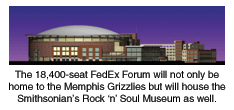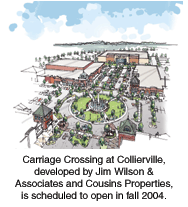| MEMPHIS GROWS DESPITE DOWN ECONOMY
Like many communities across the country, Memphis, Tennessee,
endured a year of economic downturns in 2002 but ended with good news. For
the sixth consecutive year, capital investment in the Memphis area exceeded
$1 billion, resulting in 8,352 new jobs and causing more than 8.4 million
square feet of real estate activity in 2002. Economic growth and investment
from both national and international business remains a top community priority,
and Memphis expects to remain the world’s Number 1 cargo airport for
the 10th consecutive year.
 Downtown,
the renaissance continues. Downtown Memphis’ vitality revolves around
entertainment, sports and musical culture, including AutoZone Stadium’s
record-breaking baseball success, the development of Peabody Place, the
opening of the convention center, the remake of the Cannon Auditorium
and Beale Street. Construction is well underway on the new 18,400-seat
FedEx Forum, which will house the Grizzlies, Memphis’ NBA team, when
it opens in 2004. In addition, the FedEx Forum will be home to the Smithsonian’s
Rock ‘n’ Soul Museum. Downtown,
the renaissance continues. Downtown Memphis’ vitality revolves around
entertainment, sports and musical culture, including AutoZone Stadium’s
record-breaking baseball success, the development of Peabody Place, the
opening of the convention center, the remake of the Cannon Auditorium
and Beale Street. Construction is well underway on the new 18,400-seat
FedEx Forum, which will house the Grizzlies, Memphis’ NBA team, when
it opens in 2004. In addition, the FedEx Forum will be home to the Smithsonian’s
Rock ‘n’ Soul Museum.
Voted the fastest growing downtown in America in 2000, the Memphis central
business district is experiencing phenomenal growth in apartments and
condominiums with more than 10,000 new residents. Trendy loft apartments
dot the South Main gallery district and new restaurants and retail projects
continue to be developed. A new $19 million downtown elementary school
will open its doors in August. The Third Street and Union Avenue block
that boasts the AutoZone Stadium and bustling Toyota Center won the Urban
Land Institute’s 2002 Award of Excellence. This Ballpark District,
once a site for empty lots, abandoned buildings and X-rated movie theatres,
won for its tremendously successful revitalization.
A $160 million Uptown Project is underway to develop more than 1,100
new residences in an area much in need of renewal. The city’s Pinch
District, also located downtown, is preparing for an economic boost as
a result of the new convention center, Cannon Auditorium and the $1 billion
expansion that St. Jude first began in 1999. First Alliance Bank is building
a new branch in the same downtown area. Developers are extremely optimistic
that their redevelopment efforts will be successful.
- Larry Jensen, president, Commercial Tennessee, Inc.
Retail
Memphis’ retail landscape experienced a healthy 2002, and 2003
is poised for similar growth due to ongoing new development and interest
in the market from national retailers.
New grocery operators entering the Memphis market include Aldi, The
Fresh Market and Wal-Mart’s Neighborhood Market. St. Louis-based
Schnuck Markets Inc. bought 12 Albertsons-owned Seessel’s supermarkets
and has announced plans to build two new stores and replace an existing
location with a new store. The new locations will be in Collierville at
Poplar and New Byhalia at Stage Road and Fletcher Trace Parkway.
Another retailer new to Memphis is Kohl’s, which has announced
plans to open at least three stores next year. Target Corporation is said
to be interested in expanding in Memphis as well, with the possibility
of three new stores, one of which could be a SuperTarget.
Downtown/Midtown is once again becoming a viable area for retail. Home
Depot has purchased the Center City Shopping Center at Poplar and Avalon
as a possible location for a store site.
Southeast Shelby County is a hot new area for retail development, especially
along the eastern section of Winchester Road. The demographics of Memphis
are known to shift to the east approximately every 10 years, and this
is fueling retail growth in southeast Memphis.
A number of malls in the Memphis area are on the market — including
Hickory Ridge and Southland. Raleigh Springs Mall is losing one if its
anchors. After Goldsmith’s leaves, Raleigh Springs will have only
one remaining anchor. The retailer announced it will close its Raleigh
Springs Mall location in mid-April.
New retail developments to be completed in 2003 include the Wal-Mart
Neighborhood Market at Hickory Hill and Mt. Moriah roads. Collierville
will be the focus of attention in 2003 as Carriage Crossing, a $100 million
lifestyle center, is developed by Jim Wilson & Associates and Cousins
Properties. The companies will begin construction this summer and the
center will open next year. Carriage Crossing, which will have six multi-tenant
buildings and three anchor stores, will be developed on 93 acres at Bill
Morris Parkway and Houston Levee.
Olive Branch and Southaven in DeSoto County are also attracting developers.
CBL & Associates Properties is planning to build a 1 million-square-foot
mall on 150 acres just south of Goodman Road and east of Interstate 55.
Ford Lurie Commercial Realty Associates will begin construction on a
new 65,000-square-foot shopping center in May. The shopping center will
front Germantown Parkway in Cordova.
- Lynn Leonard, NewBridge Retail Advisors
Medical/Office
The dramatic change in medical services delivery has created a strong
medical office market in Memphis over the last several years.
“Patient convenience and insurance are the two driving factors
in the move to bring care to the patient base. Insurance companies are
shortening hospital stays and ambulatory healthcare facilities are the
order of the day,” says Larry Henson, vice president of research
and information for the Memphis Regional Chamber.
Construction activity in medical real estate was the bright spot for
commercial real estate when speculative office development slowed. Strategic
repositioning and expansion among the city’s premier practices has
resulted in a surge of build-to-suits in the Wolf River medical corridor.
Following the lead of The Campbell Clinic’s landmark 60,000-square-foot
facility on Germantown Parkway at Wolf River Boulevard and the West Clinic
at Humphreys Center North, major new medical developments include Semmes
Murphey (50,000 square feet), Stern Cardiology (55,000 square feet), Boston
Baskin Cancer Group (97,000 square feet) and a 12,000-square-foot ambulatory
surgery center addition for The Campbell Clinic. In addition, Baptist
Memorial Healthcare relocated its corporate headquarters to a new 180,000-square-foot
building in the east Memphis area.
“Although many of the larger firms are now positioned in east Memphis,
we expect the trend toward freestanding facilities to continue, alongside
the historically viable alternative of medical office space adjacent to
the major hospitals,” says Steve Bowie, senior vice president at
Commercial Tennessee.
As a result, many of the large practices have relocated significant
facilities from the central medical district, including the closing of
the 1,700-bed Baptist Memorial Hospital (BMH). BMH made a gift of its
facilities to the University of Tennessee (UT) Health Science Center and
a newly created Memphis Biotech Foundation (MBF). MBF has assumed the
role of developing the biosciences and research industry cluster for the
Memphis region, and its efforts are well underway. Architects and engineers
have already been selected to begin Phase I, a six-story, 165,000-square-foot
facility to hold biotechnology research activities for multiple tenants.
Up to 1.2 million square feet of research space can be developed on the
former BMH site.
“The development of the UT-Baptist Research Park represents an
important step in establishing the infrastructure of this next economic
development engine for the Memphis community,” says Stephen Berger,
AIA. Berger is with architecture firm TRO; he is principal in charge for
the Biotech project. “It will be the heart of research and commercialization
for the biotech industry in Memphis.”
Like many other cities, Memphis carries a large inventory of sublease
space in the speculative office market. Office sublease inventory totaled
500,099 square feet at the end of 2002, which represented a drop from
the more than 600,000 square feet at the end of second quarter 2002, although
a slight increase over the third quarter’s 471,254 square feet. Tenants
found that landlords were willing to make significant concessions to help
fill their empty spaces, and in many cases, cheaper rates allowed tenants
to upgrade to Class A buildings. Completion of International Paper’s
Tower III and the first building in the Tournament Trails development
added a total of 275,000 square feet of new space to the market. Year-end
absorption for the overall office market totaled 108,369 square feet,
a significant improvement from fourth quarter 2001’s total of negative
234,315 square feet. Also up from fourth quarter 2001 was the overall
Memphis area average asking rental rate, $16.56, representing a 3-cent
increase over fourth quarter 2001.
- Larry Jensen, president, Commercial Tennessee, Inc.
Industrial
The largest single industrial lease in the city’s history, a 922,500-square-foot
space for Thomson Multimedia, could not keep the Memphis industrial market
out of the red for 2002’s absorption figures. Fourth quarter statistics
showed that the industrial market suffered negative 408,791 square feet
in absorption. Though construction slowed, 220,000 square feet of new
space was added in 2002. Sublease offerings totaled 3.49 million square
feet by year-end, an increase of more than 1 million square feet over
the third quarter. Asking rental rates for new space experienced a decline
at year-end. Overall bulk rates averaged $2.32 per square foot, overall
standard distribution rates were $2.25 and service center rates were $5.86.
Despite a dismal year in the industrial real estate market, many brokers
expect a turnaround by the end of 2003.
“There are a lot of major users in the market currently looking
for big box space, and the first quarter has seen a lot of activity. Hopefully,
by the end of the fourth quarter the poor industrial market will seem
just like a bad dream,” says Wyatt Aiken, senior vice president for
Commercial Tennessee.
- Larry Jensen, president, Commercial
Tennessee, Inc.
| NEO-TRADITIONAL CENTER
TO OPEN IN COLLIERVILLE NEXT YEAR
Jim Wilson & Associates and Cousins Properties
are working on a new open-air center in Collierville, Tennessee, a
suburb of Memphis. Carriage Crossing at Collierville, designed by
CMH Architects of Birmingham, Alabama, is an 810,000-square-foot specialty
retail center scheduled to open in fall 2004.
Carriage Crossing’s design embodies the Main Street concept
with features such as raised pedestrian crosswalks paved with brick,
as well as seating  areas
defined by low brick walls and lush landscaping. The center will
have a strong village-type atmosphere capturing the feeling of small
town America and will include details derived from historic downtown
Collierville. areas
defined by low brick walls and lush landscaping. The center will
have a strong village-type atmosphere capturing the feeling of small
town America and will include details derived from historic downtown
Collierville.
The tree-lined sidewalk areas will incorporate brick paving, traditional
street lights, courts, fountains and sculptures. The two Main Street
areas will form a cross, the intersection of which will be a large
circular village green. There will also be a separate children’s
park located near the child-oriented merchants.
Buildings along Main Street will be neo-traditional with varied
façades and storefronts, incorporating brick, Renaissance
stone, stucco, concrete details, wood, standing seam metal roofs
and ornamental light fixtures. Towers and turrets will accentuate
major street corners and provide visual landmarks for shoppers.
The tenant roster will consist of local and national retailers
— department stores and specialty shops — that will appeal
to the upscale demographics in the market. The use of the Main Street
concept will allow shoppers to park in front of the shops, while
having easy access to the department store at the “end”
of the street. There will also be parking fields around the perimeter
of the project to serve the three major anchors as well as the shops.
|
©2003 France Publications, Inc. Duplication
or reproduction of this article not permitted without authorization
from France Publications, Inc. For information on reprints of
this article contact Barbara
Sherer at (630) 554-6054.
|
